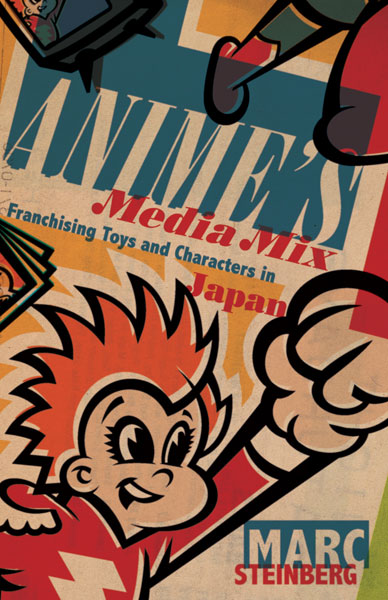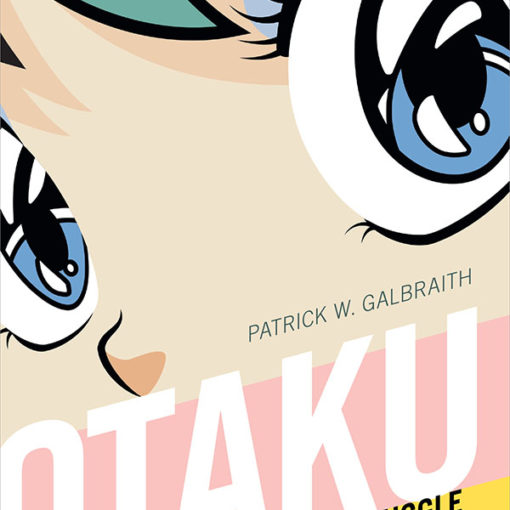Steinberg, Marc. Anime’s Media Mix: Franchising Toys and Characters in Japan. Minneapolis: University of Minnesota Press, 2013.
Alexander Zahlten
We have no doubt entered the age of the “trans-”. Conferences and journal articles are brimming with transnational, transdisciplinary, and transgender concerns. Indeed transmedia has become one of the central concepts of the re-reinvigoration of the study of media in the last ten to fifteen years. Marc Steinberg’s book Anime’s Media Mix: Franchising Toys and Characters in Japan sets out decisively to broaden the perspective with which the term “transmedia” has been associated since the mid-2000s. For this reason it is one of the most important books published both in the study of media and in area studies in recent years.
In the field of media studies, “transmedia” has been an immensely fruitful and important term. Henry Jenkins, starting with his book Convergence Culture: Where Old and New Media Collide (2006), has probably been its most successful theorist. Jenkins pointed out that a massive shift has taken place in how the media permeating our lives are produced and consumed, and how they create meaning. He was one of the most vocal in insisting that we look at connections across media platforms to understand our mediatized world. And while Jenkins’ immensely successful concept of “transmedia storytelling” as formulated in Convergence Culture has to some degree become the version of transmedia, it has also from the beginning been glaringly local, modeled on a very specific practice taking place in Hollywood, USA.
Steinberg’s contribution however is not merely additive. The book’s exploration of the history of what in Japan is called the “media mix” raises questions that force media studies to rethink the dominant conception of “transmedia” dynamics. Alan Williams’ still largely unanswered 1984 plea for genre theory to “get out of the United States” if it wants to gain any really applicable perspective was based on the realization that deriving models from only one specific context will limit our wider understanding, and may even be misleading. There is of course nothing wrong with theories that apply only to specific cases. In Convergence Culture Jenkins’ fascinating descriptions of the Matrix franchise or the TV series Lost’s principle of “transmedia storytelling” offer a compelling description of how each medium makes its own “unique contribution” to the whole, with different sections of the storyworld distributed across video games, animation, comic books, live-action films and other platforms. Jenkins also posits a centralized transmedia auteur who coordinates all of the elements to create a cohesive and contradiction-free storyworld.
Anime’s Media Mix paints a very different picture of media dynamics in Japan, and locates the beginning intensification of the interconnection of media in the appearance of what can be called the first anime series, Tetsuwan Atomu (broadcast in the U.S. as Astro Boy). Steinberg sees the formal elements of this seminal TV series as central to enabling what would arguably become the most vigorously interconnected media ecology in existence today. Anime here has to be distinguished from animation as not only a certain kind of text but a specific – an intensified – node connecting media platforms as much as the levels of economy, aesthetics, and principles of consumption. The production process of anime was designed for maximum cost effectiveness and resulted in a specific set of stylistic attributes that were quickly named “limited animation.” Such animation develops a specific relationship between stillness and movement with certain images or sections often staying still for extended periods of time. It is this aesthetics of negotiating stillness and movement that Steinberg sees as central and terms “dynamic immobility” (69). It enables the mobility of characters across different media formats and platforms and allows a character such as Atomu (Astro Boy) to shift between manga, anime, toys, stickers and other formats. And while Steinberg’s investigations into the ontology of characters are neither exhaustive nor his focus, they open a door to thinking about how it is also this effortless shift between appearing in a manga/anime and becoming a toy/sticker is relevant today for the curious ontic qualitystatus of the type of fictional character that is highly mobile across media platforms, and that It? G? has termed kyara. The various chapters of the book offer a detailed and captivating, theoretically stimulating account of how advertising and anime production congealed to establish a new mode of media consumption, and ultimately new ways of constructing meaning.
The volume moves effortlessly between rich historical detail on 1960s and 1980s surges in media mix principles, their discursive history, and more theoretically speculative sections. In this way, Steinberg contributes to a subtle and much needed trend in film studies: the re-adjustment of the “turn to history” that took hold in the late 1980s and throughout the 1990s. While that turn itself was highly necessary and a reaction to the perceived excesses of structuralist and then postmodern theory, it also closed down many avenues for further discussion. Broadly speaking, the new perspective was that history, now in the form of discursive history, needed to be uncovered; once this had been done there would be little left to do except fill in the ever-more finely distributed blanks with more historical research. In contrast, Anime’s Media Mix tends equally to history, discourse and theory. One fascinating example is Steinberg’s elaboration of the 1960s Japanese advertising industry concept of mono komi, or “thing communication,” which he proposes can be understood not only as a shift to things (toys, stickers) as media, but also as a shift to human-human, human-thing, and thing-thing interactions. The latter especially opens up a world of possibilities for connecting to recent developments in Object Oriented Ontology or thing-phenomenology. In the end Steinberg does not have the space to elaborate all of these possibilities fully. This is no doubt a necessary compromise for an expansively conceived but very tightly executed volume, and nothing to quibble about. However it does at times leave the reader eager for more.
If there is any quibble at all with this immensely important book, it is that Steinberg to a minor degree repeats Jenkins’ pattern of totalization. The development of the media mix for Steinberg is tied to two industrial entities and two personages. Tezuka Osamu, the “god of manga” and his animation company Mushi Pro stand at one end. Kadokawa Tsuguhiko, head of the media conglomerate Kadokawa, stands at the other. The former is credited with establishing anime’s aesthetics and its basic business model by first creating the Atomu manga character and then founding Mushi Pro to develop the anime. The latter is credited with establishing and exploiting the media mix through systematic tie-ups which he instituted initially as head of Kadokawa’s magazine division. The focus on Kadokawa Tsuguhiko is no doubt legitimate for the kind of media mix on which Steinberg is focusing. But just as we have to posit that there is more than just one transmedia, so there would seem to have been very different media mix models that prefigured and enabled Tsuguhiko’s radical business strategies. To map the family drama underlying this historical narrative in detail would go too far here, but Tsuguhiko’s elder brother and former Kadokawa head Haruki is immensely important in this context. In Japan the flamboyant über-businessman is usually – correctly or not is a different question – credited with introducing media mix strategies in the 1970s when he led the publishing company into the production of film and other media. The difference lies in Haruki’s focus on connecting film, soundtracks and literature first through blockbusters and then through idol actresses, creating a very different dynamic than Tsuguhiko’s (initial) focus on magazines, manga, video games and characters. The point is less to valorize one over the other than to see both strategies as fairly different beasts, with very different effects. To emphasize Tsuguhiko’s innovations, Steinberg follows the version of history upheld by the company and Otsuka Eiji (who once worked for Tsuguhiko at Kadokawa), and uses Haruki’s business model mainly as an antiquated foil against which to define the media mix. This sharpens his argument but is also problematic, as there are many different media mix models, with specific continuities and differences between them.
Anime’s Media Mix’s methodology is exemplary, and it deftly navigates current trends in the scholarship on anime, media industries, and media studies more generally – a difficult feat to say the least. It draws upon the brilliant formalist analyses of anime in Thomas Lamarre’s work, while importantly expanding the perspective to think about larger systems of production, consumption, and mediation that affect all media culture today. That this ground-breaking book has not yet won an array of awards is somewhat baffling, and may point to the fact that it is not easily categorizable along the boundaries that disciplines tend to set up. It will hopefully, however, play an important role in renegotiating them.
Alexander Zahlten is an assistant professor in the Department of East Asian Languages and Civilizations at Harvard University. He has written on Pink Film, the role of postcolonial fantasy in Korean “remakes” of Japanese films, and the question of categories in a media mix environment. He has curated film programs for institutions such as the German Film Museum and the Athene Francais Cultural Center, Tokyo, and was Program Director for the Nippon Connection Film Festival, the largest festival for film from Japan, from 2002 to 2010.


